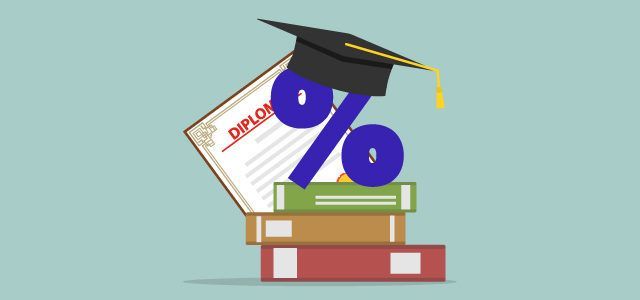Pay close attention to your student loan interest rates if you have student debt or plan to borrow money for college. The greater the interest rate, the more you'll pay, whereas the lower the interest rate, the less you'll pay. So, what is the typical interest rate on student loans? From 2006 through 2021, the average federal student loan rate for undergraduate and graduate loans was 4.66 percent and 6.22 percent, respectively. However, depending on your loan, including federal and private student loans, and whether you had a cosigner, your rate may be much outside this range. Here's a rundown of the typical student loan interest rates and an explanation of how they're calculated.
Federal Student Loan Interest Rates In USA
| Student Loan Type | Borrower Type | Average Student Loan Interest Rate (2006–2021) | Current Student Loan Interest Rates (2021–22) |
| Direct subsidized and unsubsidized loans | Undergraduate students | 4.66% | 3.73% |
| Direct unsubsidized loans | Graduate or professional students | 6.22% | 5.28% |
| Direct PLUS loans | Parents of undergraduate students and graduate or professional students | 7.27% | 6.28% |
What Affects Federal Student Loan Rates?
Here are some of the elements that influence your interest rate:- What type of student loans you're getting. Direct subsidized and unsubsidized loans have the lowest interest rates, while PLUS loans have higher rates.
- What type of borrower you are. Undergraduate students pay 1.55 percentage points less in interest on direct unsubsidized loans than graduate or professional school borrowers.
- When you take out a loan. Interest rates on federal student loans are set each year on June 1 and are in effect from July 1 through June 30 of the following year. The federal student loan rate will be given to your loan depending on the date of the first disbursement.
- Recent 10-Year U.S. Treasury yields. The 10-year Treasury yield plus a set add-on amount is used to calculate federal student loan rates. Student loan rates climb and fall in lockstep with Treasury yields, up to a rated maximum imposed by law.
Private Student Loan Interest Rates
While federal student loan rates are uniform for all borrowers of a particular type of loan, private student loan rates vary significantly. Here are some figures about the typical private student loan for undergraduates:- The average starting rate for five-year private student loans with variable rates is 6.17 percent.
- For 10-year private student loans, the average fixed rate is 7.64 percent.
- Variable rates start at 1.25 percent and go up to 2.25 percent APR, while fixed rates start around 4.25 percent and go up to 4.75 percent APR.
- Private student loan rates might range from 11.97 percent to 12.59 percent APR on the upper end.
What Affects Private Student Loan Rates?
It's difficult to predict how much you'll pay for a private student loan with fixed rates ranging from 4.25 percent to 12.59 percent. Private student loan rates are affected by the following factors:- Which lender do you choose. While many lenders offer similar and competitive rates, some may be able to give a better bargain. Obtaining rate quotations might assist you in locating the lender that offers the best deal for you.
- How creditworthy you (and your cosigner) are. To qualify for a private student loan, you'll typically need an excellent credit score (in the mid-600s or higher). Lenders frequently link student loan rate offers to your credit score, so you'll get higher rates if you have good credit. You can add a cosigner to your application if your credit score does not exceed this requirement.
- The terms of your private student loan. The loan alternatives you choose will influence the interest rate you pay. Variable-rate student loans, for example, have lower interest rates at first but might climb or fall in repayment. Fixed rates, on the other hand, may be higher at first but are locked in through repayment and will not alter. Many lenders also offer reduced interest rates on student loans with shorter maturities.
- The general rates environment when you originate a loan. You can anticipate private student loans to follow the general trend of rising or falling interest rates. Private student loan rates are influenced by what's happening in the bigger markets and economy, similar to how U.S. Treasury yields influence federal student loan rates.


